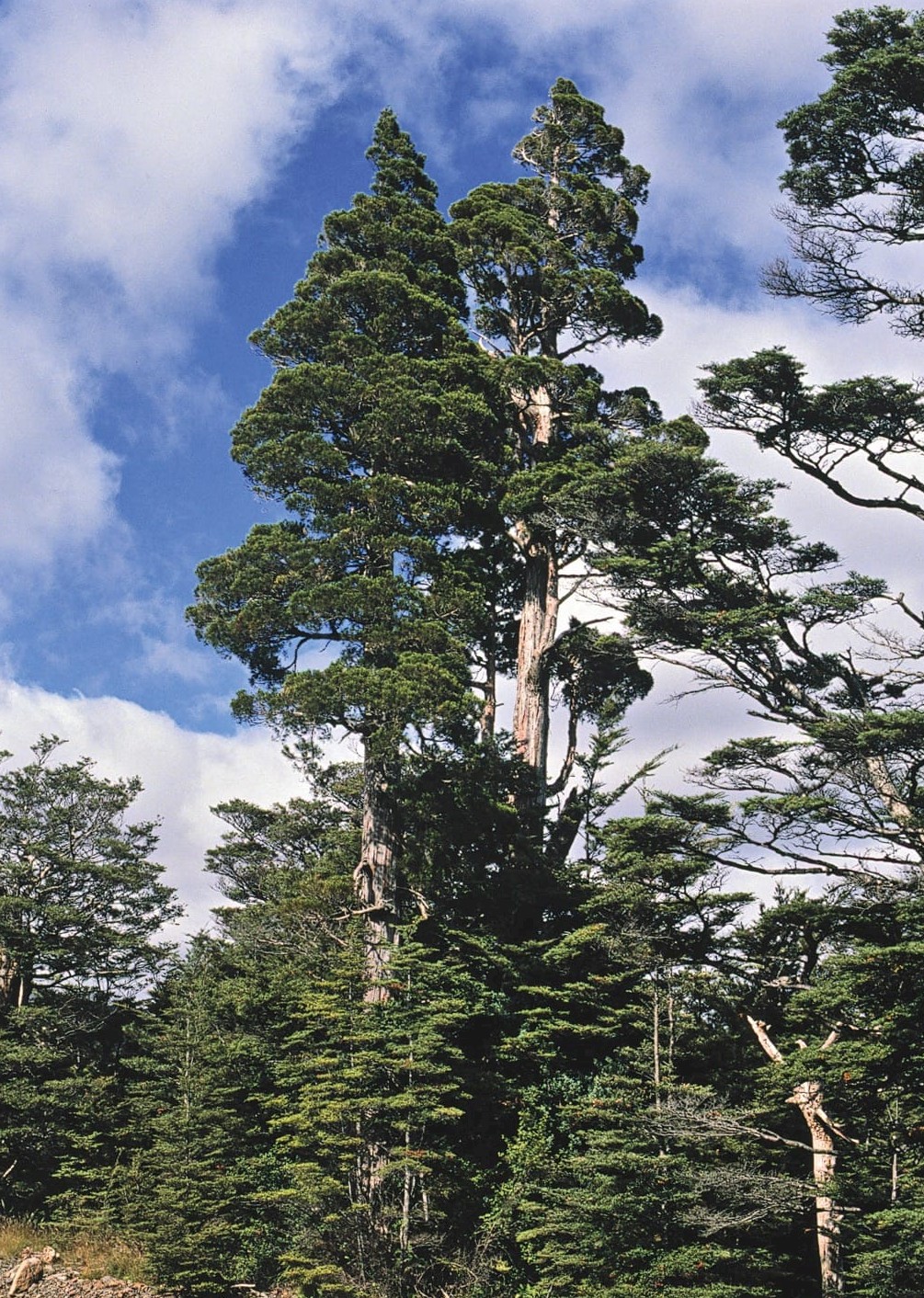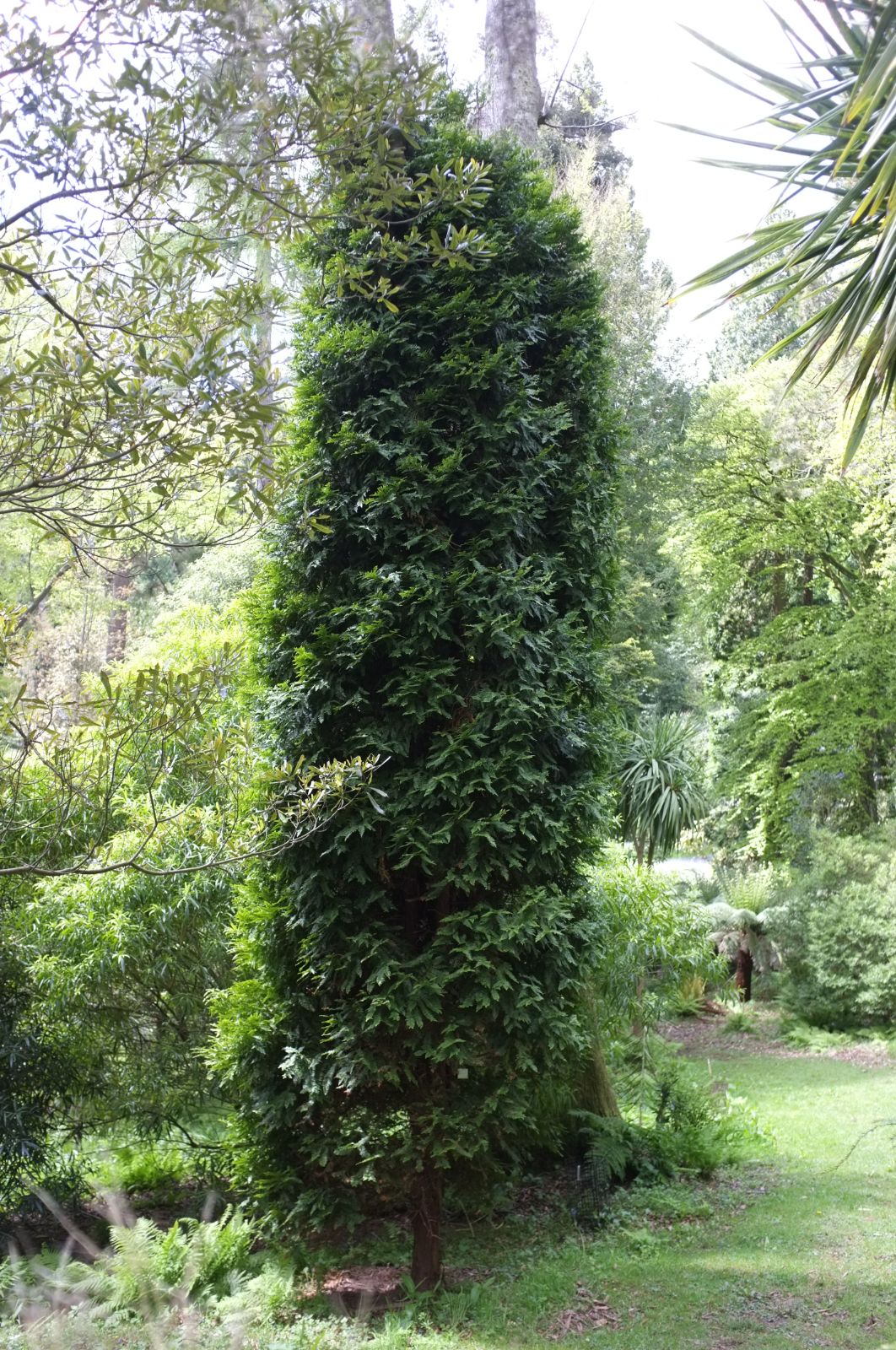Libocedrus
Credits
Article from Bean's Trees and Shrubs Hardy in the British Isles
Article from New Trees by John Grimshaw & Ross Bayton
Recommended citation
'Libocedrus' from the website Trees and Shrubs Online (treesandshrubsonline.
Family
- Cupressaceae
Libocedrus in its current delimitation includes only five species: three in New Caledonia and two in New Zealand (Farjon 2001). Libocedrus species are small to large evergreen trees or shrubs with a conical habit. The bark is thin and fibrous, and sheds in long strips. The branchlets are dorsiventrally flattened, distichous and fan-shaped. The juvenile leaves are long and spreading. The mature leaves are in pairs, scale-like, appressed and decussate; they are acute and somewhat dimorphic. Male and female strobili are solitary and terminal, and produced on different branches on the same tree. The male strobili are oblong, with 6–12 decussate sporophylls. The female cones are ovoid and erect, valvate, woody and mature in the first year. The seed scales are arranged in two basally fused, decussate pairs, though only the inner pair is fertile; the seed scales have a triangular, spiny umbo. There are one or two lenticular seeds per fertile scale, and each seed develops a short, rudimentary wing and a long, fully formed wing. The species from New Caledonia are unlikely to be hardy in temperate areas, but the two from New Zealand (L. bidwillii and L. plumosa (D. Don) Sarg.) are both in cultivation in Europe (Allan 1961, Dallimore et al. 1966, Salmon 1980).
Libocedrus uvifera can now be found under Pilgerodendron uviferum
Bean’s Trees and Shrubs
Libocedrus
A genus of evergreen coniferous trees which, in the wide sense, consists of thirteen species. Of those treated here three come from the northern hemisphere (L. decurrens from western N. America, (L. macrolepis and L. formosana from E. Asia); two are natives of temperate S. America (L. chilensis and L. uvifera) and two of New Zealand (L. plumosa and L. bidwillii). The other six species, not cultivated in this country, and certainly not hardy with us, are from New Guinea and New Caledonia.
The leading characters of this group are: Ultimate branches usually flattened (more rarely tetragonous) and arranged in one plane. Leaves scale-like. Cones small, ripening and releasing their seeds in the first season; scales four or six, valvate or imbricate, woody, the lower pair short, sterile; the next pair fertile and much larger, each scale bearing one or two seeds; the upper (innermost) pair, when present, sterile and connate. Seeds unequally two-winged.
It must be admitted that the species treated here do not form a homogeneous group. In 1931 the Swedish botanist Florin remarked that the three species of the northern hemisphere are more closely allied to Thuja than to .L. plumosa (the type-species of Libocedrus) and its immediate allies and this was also the view of Li (Journ. Arn. Arb., Vol. 34, 17–36). These three northern species, if treated as a separate genus, would take the name Calocedrus.
With the removal of these three species, all characterised by cones with six imbricate scales, the genus Libocedrus becomes more uniform, all the remaining species having cones with four valvate scales. But the two S. American species both differ in other respects from L. plumosa and its immediate allies. L. uvifera (tetragona) has uniform, spreading leaves and outwardly bears more resemblance to Fitzroya than to any libocedrus. This species was transferred by Florin in 1931 to the new monotypic genus Pilgerodendron. The other S. American species – L. chilensis – is less distinct, and was allowed to remain in Libocedrus until 1954, when it was transferred by Florin and Boutelje to another new monotypic genus – Austrocedrus. It differs from Libocedrus sens. strict. chiefly in its cones, the scales of which have a short mucro near the tip instead of the long, curved appendage on the back seen in L. plumosa and its allies; there are also differences in foliage and in wood anatomy. Finally, it should be added that the three species from New Guinea were transferred by Li in 1953 to the new genus Papuacedrus. Thus the genus Libocedrus, if the segregate genera are all to be recognised, would become a genus of five species: L. plumosa (the type-species) and L. bidwillii, both of New Zealand, and three species endemic to New Caledonia.
In this work, the older conception of Libocedrus is maintained on practical rather than taxonomic grounds. Only one species of this group – Libocedrus (Calocedrus) decurrens – is at all common in cultivation and only one other species – Libocedrus (Austrocedrus) chilensis is both hardy and worthy of cultivation. It seems best, therefore, to describe and discuss the group in one place. In the headings to the descriptions given below the correct name of the species in the segregate genus is given in capitals, before the other synonyms.
From the Supplement (Vol.V)
In the present edition of Volume II, pages 565–8, the traditional conception of Libocedrus was maintained, but the names of the species when placed in the segregate genera Austrocedrus, Calocedrus and Pilgerodendron were given in capitals at the head of the synonyms. The first two of these genera are now well established and accepted in the Kew catalogue; in the present supplement they are accordingly given their appropriate alphabetical position. The status of Pilgerodendron is less certain, however. It is retained in Libocedrus by James E. Eckenwalder in ‘Re-evaluation of Cupressaceae and Taxodiaceae: a proposed merger’, in Madro***ño, Vol. 23, pp. 237–56 (1967).
Libocedrus, as now understood, has two species in New Zealand, both in cultivation here, three in New Caledonia and, if Pilgerodendron be restored to it, one in southern Chile and Argentina.


